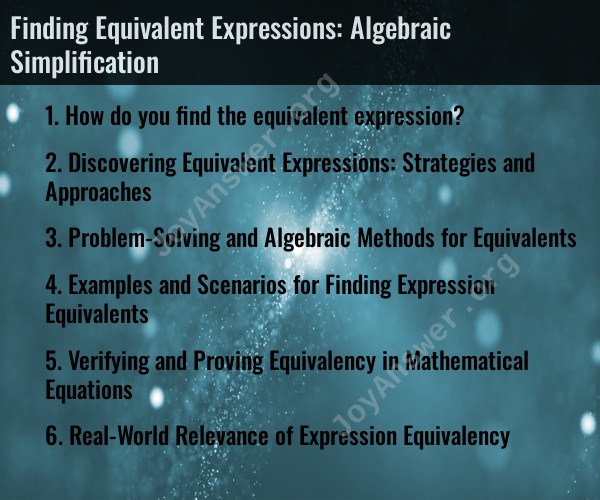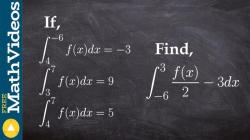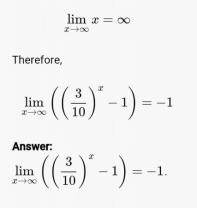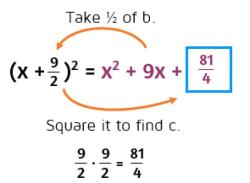How do you find the equivalent expression?
To find an equivalent expression in algebra, you typically simplify, manipulate, or rewrite the original expression while preserving the equality of the two expressions. The goal is to make the expression easier to work with or to reveal certain mathematical properties. Here are common techniques for finding equivalent expressions:
Basic Operations:
- You can perform basic algebraic operations such as addition, subtraction, multiplication, and division to simplify an expression. For example, combining like terms or factoring common factors can lead to equivalent expressions.
Using the Distributive Property:
- Applying the distributive property is a common method. This involves factoring out a common term from multiple terms in an expression.
Combining Like Terms:
- Combine like terms that have the same variables and exponents. For example, can be combined into .
Expanding and Factoring:
- You can expand an expression by multiplying it out, or you can factor it by identifying common factors. Factoring can help in simplifying and finding equivalent expressions.
Rationalizing Denominators:
- In some cases, you may need to rationalize the denominator by multiplying both the numerator and denominator by an appropriate expression to eliminate square roots or other radicals.
Using Trigonometric Identities:
- In trigonometry, you can use trigonometric identities to simplify expressions involving trigonometric functions.
Substitution:
- You can replace variables or expressions in an equation with equivalent expressions. This is often useful in solving equations, but it can also be used to find equivalent expressions.
Completing the Square:
- In quadratic expressions, you can complete the square to find equivalent forms that are useful for solving equations or graphing.
Simplifying Complex Fractions:
- Complex fractions can be simplified by finding a common denominator for the fractions within the expression.
Using Mathematical Properties:
- Applying mathematical properties such as the commutative, associative, or distributive properties can help in simplifying expressions and finding equivalent forms.
Using Special Formulas:
- Special formulas, such as the difference of squares or the sum/difference of cubes, can be applied to simplify expressions.
Algebraic Manipulation:
- Sometimes, you may need to use algebraic manipulations like cross-multiplication, taking square roots, or isolating variables to transform an expression.
The key to finding equivalent expressions is to maintain the equality of the original expression while making it more manageable, revealing specific properties, or preparing it for further mathematical operations. The specific technique you use depends on the nature of the expression and the goal you want to achieve. Practice and familiarity with algebraic rules and techniques will help you become more adept at finding equivalent expressions.
Discovering Equivalent Expressions: Strategies and Approaches
Equivalent expressions are mathematical expressions that have the same value, regardless of the values assigned to the variables. There are a variety of strategies and approaches that can be used to discover equivalent expressions.
One common approach is to use the commutative, associative, and distributive properties of arithmetic. These properties state that certain operations can be rearranged or grouped without changing the value of the expression. For example, the commutative property of addition states that a + b = b + a. This means that the expressions 3 + 2 and 2 + 3 are equivalent.
Another approach to finding equivalent expressions is to use factoring and simplification techniques. Factoring involves breaking down an expression into smaller, more manageable parts. Simplification involves combining like terms and removing unnecessary factors. For example, the expression 2x + 6x can be simplified to 8x.
Problem-Solving and Algebraic Methods for Equivalents
Equivalent expressions can be used to solve a variety of mathematical problems. For example, equivalent expressions can be used to:
- Solve linear equations and inequalities.
- Simplify complex expressions.
- Prove mathematical identities.
- Develop new mathematical formulas.
Algebraic methods can be used to manipulate and solve equivalent expressions. Some common algebraic methods include:
- Completing the square
- Using quadratic equations
- Using factoring
- Using substitution
Examples and Scenarios for Finding Expression Equivalents
Here are a few examples of equivalent expressions:
- 3x + 2 and 2 + 3x (commutative property of addition)
- (x + 2)(x - 3) and x^2 - x - 6 (factoring)
- 2(x + 3) and 2x + 6 (distributive property of multiplication)
- 1/(x + 1) and 1 - 1/(x + 1) (subtraction)
Here is a scenario where equivalent expressions can be used to solve a problem:
Suppose you are given the following equation:
2x + 3 = 7
You can solve this equation by subtracting 3 from both sides:
2x + 3 - 3 = 7 - 3
This gives you the following equivalent equation:
2x = 4
You can then divide both sides by 2 to solve for x:
2x / 2 = 4 / 2
This gives you the solution x = 2.
Verifying and Proving Equivalency in Mathematical Equations
There are two main ways to verify and prove equivalency in mathematical equations:
- Substitution: One way to verify that two expressions are equivalent is to substitute the same value for all of the variables in the expressions and see if they evaluate to the same value. For example, to verify that the expressions 3x + 2 and 2 + 3x are equivalent, you could substitute x = 1. Both expressions would evaluate to 5, which proves that they are equivalent.
- Algebraic proofs: Algebraic proofs can be used to prove the equivalence of two expressions without having to substitute specific values for the variables. Algebraic proofs typically involve manipulating the expressions using algebraic properties and identities.
Real-World Relevance of Expression Equivalency
Expression equivalency is a fundamental concept in mathematics. It is used in a variety of mathematical fields, including algebra, geometry, calculus, and statistics.
Expression equivalency is also used in many real-world applications. For example, engineers use expression equivalency to design and build bridges, buildings, and other structures. Economists use expression equivalency to develop and analyze economic models. Scientists use expression equivalency to derive and test scientific theories.
Overall, expression equivalency is a powerful tool that can be used to solve a variety of mathematical and real-world problems.













